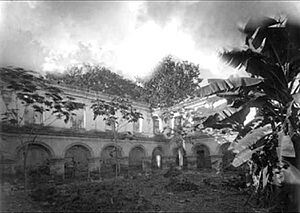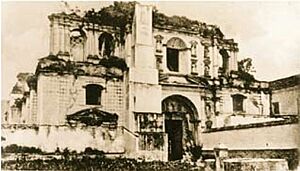Iglesia y Convento de la Compañía de Jesús, Antigua Guatemala facts for kids
Quick facts for kids Convent and Church of the Society of Jesus |
|
|---|---|
|
Iglesia y Convento de la Compañía de Jesús (Spanish)
|
|

View of the remnants of the church after the Santa Marta earthquake
|
|
| General information | |
| Architectural style | Spanish seismic baroque |
| Location | Antigua Guatemala, Guatemala |
| Coordinates | 14°33′27″N 90°44′08″W / 14.55750°N 90.73556°W |
| Construction started | 1690 |
| Completed | October 21, 1698 |
| Destroyed |
|
| Owner | Cooperación Española-AECID |
| Design and construction | |
| Architect | José de Porres |
The Church and Convent of the Society of Jesus in Antigua Guatemala is an old religious building complex. It was built between 1690 and 1698. The complex is located very close to the Cathedral of Saint James. It used to have three monastery sections and a church.
Even though it was a large building, only about 13 Jesuit priests lived there at a time. They also welcomed other Jesuit brothers and students who were not priests. A school called the San Lucas School of the Society of Jesus was inside the building. This school operated until the Jesuits were asked to leave the Spanish colonies in 1767.
History of the Jesuit Complex
When did the Jesuits arrive in Guatemala?
In the late 1500s, the Society of Jesus, also known as the Jesuits, was very respected in Europe. The Spanish colony of Guatemala asked for a group of Jesuits to come in 1561. At first, King Felipe II said no. He wanted the Jesuits to stay in Spain to help with important religious changes.
However, five years later, King Felipe II himself asked for Jesuits to be sent to the Americas. But this plan didn't work out right away. In 1580, a priest named Juan de la Plaza visited Guatemala. He asked the local leaders, called criollos (people of Spanish descent born in the Americas), to allow the Jesuits to come. Finally, in 1607, the first Jesuits arrived in Santiago de los Caballeros de Goathemala, which is now Antigua Guatemala.
At that time, the city already had grand buildings like the Cathedral and the Royal Palace. Other religious groups had also started their own buildings. The Jesuits first stayed at a house belonging to Lucas Hurtado. Since teaching was very important to the Jesuits, they quickly opened a school. The San Lucas School opened on October 18, 1607. It was named after Saint Luke, who was highly respected by the Jesuits.
How was the Church built?
A generous donation from a person named Chavarri helped the Jesuits buy more land. They bought two lots on the east side of their property. This is where the entrance to the church would later be built. In 1655, the Society finally bought the entire piece of land from the Díaz del Castillo family.
By then, the San Lucas School was very famous in the region. It even gave out university degrees before the Royal and Pontifical University of San Carlos Borromeo was officially allowed by the King and Pope. In 1653, the San Lucas School had only thirteen priests working there. This was a small number for such a large building. However, the Jesuits had a big impact on the culture and education in Guatemala. Their school was the most respected in the city. Many important people in society at that time graduated from it. Most students were not priests and went on to get top jobs in the country after studying at the Royal and Pontifical University of San Carlos.
In 1690, José de Porres began building the second church. The construction took eight years. It was possible thanks to many donations from people who attended the church. Porres' son, Diego, worked on this project as an apprentice. He learned so much that he later became the city's master builder. The new church was dedicated on October 21, 1698. At that time, it was considered one of the most beautiful churches in all of Spanish America.
What happened during the San Miguel and San Casimiro earthquakes?
On September 29, 1717, the San Miguel earthquake hit the city. It badly damaged the San Lucas School building. The earthquake cracked the church tower and broke the top part of the main gate. Diego de Porres, the master builder of Santiago de Guatemala, checked the damage. He estimated that it would cost a lot of money to fix it.
However, three years later, the Jesuits had rebuilt the structure. When the master builder came back to inspect the building, he said it was even better and prettier than before. But on March 4, 1751, the San Casimiro earthquake struck. This earthquake destroyed the church roof. The Jesuits had to ask for help from the community again to rebuild. Once more, after repairs were finished, the building was one of the most beautiful in the city.
After the San Casimiro earthquake, the city entered a time of growth. Many improvements were made, like making the streets nicer and adding a tap water system. A new City Hall was built. In 1753, work on the Jesuit plaza in front of the church was completed.
Why were the Jesuits expelled?
In 1765, the Spanish King made new rules called the Bourbon Reforms. These rules aimed to give the King more power over the Spanish colonies. They also wanted to collect more taxes for the Crown.
The King also wanted to reduce the power of the Catholic Church. Until then, the Church had a lot of influence over the Spanish people. This new policy was based on new ideas from the Enlightenment period. It had several main goals:
- To lessen the cultural influence of the Jesuits.
- To move towards a more non-religious culture.
- To promote new ways of thinking and learning.
- To value natural science more than religious beliefs.
- To question the Church's role in society.
- To increase the King's authority over religious matters.
A building called the "Casa de Ejercicios" (House of Spiritual Exercises) was finished in 1767. It was next to the San Lucas School. But on April 2 of that year, King Carlos III signed an order. This order said that the Society of Jesus must be expelled from all his kingdoms.
In Guatemala, the Jesuit priests were gathered. Their properties were taken away from the San Lucas school early on July 1, 1767. They were then sent to the Gulf of Honduras, where a ship was waiting to take them out of the country. The San Lucas school building was closed. The Jesuits' properties were sold off by a royal committee. By 1770, it was decided to use the former Jesuit properties for schools, missions, and hospitals.
What happened during the Santa Marta earthquake?
The terrible Santa Marta earthquake hit the city on June 29, 1773. It almost completely destroyed the church and parts of the convent. Its courtyards and towers were in ruins. The walls were leaning dangerously, and the "Casa de Ejercicios" was turned into rubble.
By a royal order in 1775, the city was told to move to a new location called the "Virgin valley." This was a final command that everyone had to follow. People slowly started to move in December of that year. To build the new city, construction materials were taken from the old, abandoned churches in Santiago de Guatemala. However, in the case of the Society of Jesus church, many neighbors did not want it to be taken apart. They believed it could still be repaired.
What happened after the capital moved?
After Guatemala became independent from Spain in 1821, the Jesuit complex became public property again. It was involved in several legal battles until 1829. At that time, religious orders and conservative groups were expelled from Central America. This happened after a liberal general named Francisco Morazán took control and set up a non-religious government. The new government ordered that all confiscated Catholic church properties be turned into elementary schools and university classrooms.
In 1843, the conservative president Rafael Carrera allowed the Society of Jesus to return to Guatemala. He was advised by a high-ranking conservative priest. However, because of constant wars against liberal governments in Central America, the Jesuits could not fully return until 1851. This was after Carrera had firm control of the country. They were given a school in Guatemala City. It is not known if they tried to get back their old properties in Antigua Guatemala.
By 1865, the building was used as a thread mill that ran on steam power. But it wasn't making money because there weren't enough skilled workers or raw materials. In 1872, the Jesuits were again expelled from Guatemala by the liberal government of Justo Rufino Barrios.
In 1884, the City Hall announced that it planned to turn the old Jesuit buildings into a market. Many neighbors were against this idea because they already had small shops in the plaza. It wasn't until 1912 that a market was finally placed in the complex.
In 1979, the complex was recognized as a "Patrimony of Humanity" by UNESCO. This means it is considered a very important cultural site for the whole world.
Restoration of the Complex
Later, the building hosted a market for Guatemalan handmade products. In 1992, the International Cooperation Agency for Development from Spain agreed to restore the school building. In return, they would be able to use it to create an international educational center. This plan was approved by the National Council for Antigua Guatemala Protection.
See also
 In Spanish: Iglesia y Convento de la Compañía de Jesús (Antigua Guatemala) para niños
In Spanish: Iglesia y Convento de la Compañía de Jesús (Antigua Guatemala) para niños







